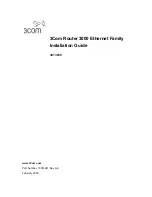
Firewall functions: IPTABLES
U
SER
G
UIDE
168
F
IREWALL FUNCTIONS
:
IPTABLES
I
NTRODUCTION
The Imola command
iptables
is an advanced tool for packet filtering on the network: it checks
packets trying to access, transit and exit from the router. It has the following functionality:
Firewall, both stateless and stateful
Network Address Translation (NAT), both static and dynamic
Alteration and marking of packets(mangle)
Accounting and logging of packets
Port forwarding
Load balancing
T
ABLES
,
CHAINS
,
RULES AND TARGET
iptables
assembles into
tables
the rules for packet processing. There are three default tables:
filter
Governs the firewall functions: it defines which packets will be accepted or blocked
nat
Governs natting activities (
source-nat
,
destination-nat
,
pat
)
mangle
Governs mechanisms for the modifications of packets
Each table is composed of a group of predetermined chains (
INPUT
,
OUTPUT
,
FORWARD
,
PREROUTING
,
POSTROUTING
). Customized chains can optionally be added. Each
chain
is
composed of a set of
rules
which, according to a
match
criterion
,
identify the network packets:
protocol, IP address, service, etc. (e.g.:
-p tcp --dport 80 -d 10.0.1.1
).
Each
rule
terminates with an indication (
target
) which indicates what to do with the packets
identified (e.g.
-j ACCEPT, -j DROP, -j LOG,...
).
The chains indicate predetermined points (also known as hook points) during the packet
processing: in these points the packet is examined in order to apply the rule established and to
execute the target if the match associated with the rule has been satisfied.
The appropriate chains are used according to the type of table (filter, NAT or mangle). In particular,
filter functions use
INPUT
,
FORWARD
and
OUTPUT
chains, NAT functions use
PREROUTING
and
POSTROUTING
chains, mangle functions can be used within any chain. The meaning of each chain is
described in the following paragraphs.
The generic syntax of the
iptables
command is as follows:
iptables
–
t table -[AD] chain rule-specification [options]
iptables
–
t table -[I] chain [rulenum] rule-specification [options]
iptables
–
t table -D chain rulenum [options]
iptables
–
t table -[L] [chain] [options]
where the following parameters are specified: reference table (-t NAT table), adding or deleting the
rule within the chain (-A chain, -D chain, -I chain), rule for matching packets and action (target) to
be executed.
The command:
















































